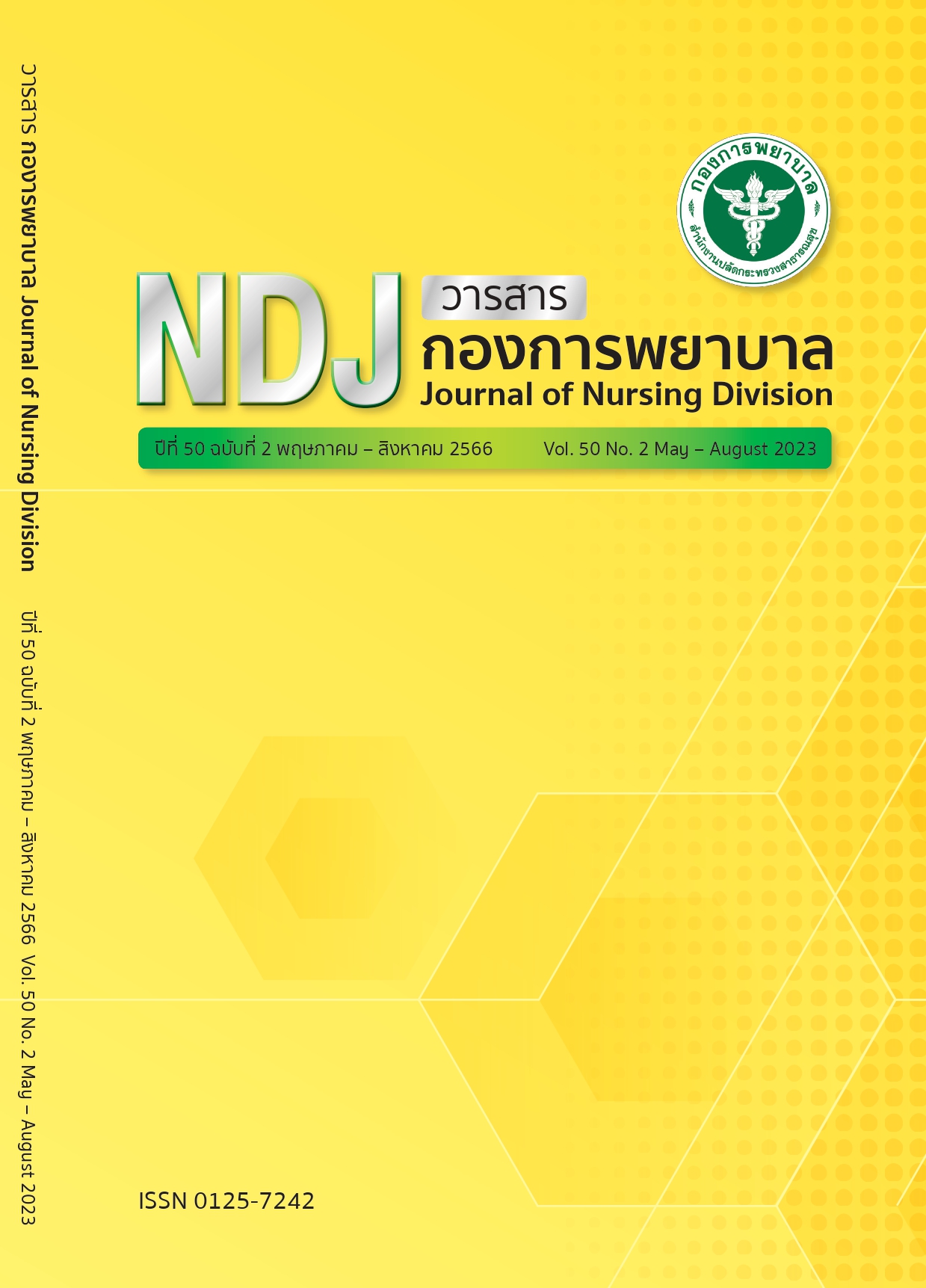การพัฒนาและประเมินผลลัพธ์การใช้แนวปฏิบัติการพยาบาลทางคลินิกการจัดการ ความปวด และการเริ่มเคลื่อนไหวร่างกายโดยเร็วในผู้ป่วยวิกฤตเด็ก
Main Article Content
บทคัดย่อ
บทคัดย่อ
การวิจัยและพัฒนานี้มีวัตถุประสงค์เพื่อพัฒนาแนวปฏิบัติการพยาบาลทางคลินิกการจัดการความปวดและการเริ่มเคลื่อนไหวร่างกายโดยเร็วในผู้ป่วยวิกฤตเด็ก และ ประเมินผลลัพธ์การใช้แนวปฏิบัติฯ กลุ่มตัวอย่างเป็นพยาบาล 19 คน และผู้ป่วยวิกฤตเด็ก 102 คน ดำเนินการ 2 ระยะ คือ (1) พัฒนาแนวปฏิบัติฯ (2) ประเมินผลลัพธ์การใช้แนวปฏิบัติ เครื่องมือวิจัยประกอบด้วย (1) แนวปฏิบัติการพยาบาลทางคลินิกการจัดการความปวดและการเริ่มเคลื่อนไหวร่างกายโดยเร็วในผู้ป่วยวิกฤตเด็ก (2) แบบประเมินการปฏิบัติตามแนวปฏิบัติ (3) แบบสอบถามความพึงพอใจของผู้ใช้แนวปฏิบัติ (4) แบบสอบถามความยากง่าย ความเป็นไปได้ของการนำแนวปฏิบัติไปใช้ มีค่าดัชนีความตรงเชิงเนื้อหาเท่ากับ .95 ค่า inter rater reliability เท่ากับ 1 วิเคราะห์ข้อมูลด้วยค่าเฉลี่ย ส่วนเบี่ยงแบนมาตรฐานและสถิติ Independent t - test
ผลการวิจัย พบว่า แนวปฏิบัติการพยาบาลทางคลินิกการจัดการความปวดและการเริ่มเคลื่อนไหวร่างกายโดยเร็วในผู้ป่วยวิกฤตเด็ก ประกอบด้วย (1) กิจกรรมการจัดการความปวด มีการประเมินและจัดการความปวด ประเมินความเหมาะสมของการใช้ยา (2) กิจกรรมการเริ่มเคลื่อนไหวร่างกายโดยเร็ว มีการประเมินข้อจำกัด ระดับความเสี่ยง เลือกกิจกรรมเคลื่อนไหวร่างกายที่เหมาะสมและเฝ้าระวังความปลอดภัยขณะทำกิจกรรม ประเมินผลลัพธ์ พบว่า กลุ่มหลังใช้แนวปฏิบัติมีค่าเฉลี่ยจำนวนวันใช้เครื่องช่วยหายใจและจำนวนวันนอนในไอซียูน้อยกว่ากลุ่มก่อนใช้แนวปฏิบัติ อย่างมีนัยสำคัญทางสถิติ p < .05 (Mean 2.84 SD 1.67 และ Mean 3.73 SD 1.93) และ( Mean 4.43 SD 2.28 และ Mean 5.71 SD 1.97) ตามลำดับ แนวโน้มอัตราปอดอักเสบจากการใช้เครื่องช่วยหายใจหลังใช้แนวปฏิบัติ ลดลงจาก 6.77 เป็น 5.22 ต่อ 1,000 วันใช้เครื่องช่วยหายใจ การปฏิบัติตามแนวปฏิบัติ ร้อยละ 96.01 ความเป็นไปได้ของการนำไปใช้และความพึงพอใจของพยาบาลอยู่ในระดับสูง (Mean 3.69 SD 0.47 และ Mean 3.69 SD 0.47)
Article Details

อนุญาตภายใต้เงื่อนไข Creative Commons Attribution-NonCommercial-NoDerivatives 4.0 International License.
เอกสารอ้างอิง
Reference
Engel J, von Borell F, Baumgartner I, et al. Modified ABCDEF - bundles for critically ill pediatric patients - what could they look like ?. Front Pediatr. 2022; 10: 1-11. doi: 10.3389/fped.2022.886334.
Cameron S, Ball I, Cepinskas G, et al. Early mobilization in the critical care unit: A review of adult and pediatric literature. J Crit Care. 2015; 30(4): 664-672. doi: 10.1016/j.jcrc.2015.03.032.
Smith HAB, Besunder JB, Betters KA, et al. Society of critical care medicine clinical practice guidelines on prevention and management of pain, agitation, neuromuscular blockade, and delirium in critically ill pediatric patients with consideration of the ICU environment and early mobility. Pediatr Crit Care Med. 2022; 23(2): e74-e110. doi: 10.1097/PCC.0000000000002873.
Hatyai Hospital. Statistic data of Patient in PICU ward Hatyai Hospital. Songkhla. 2022.
Ista E, Redivo J, Kananur P, et al. ABCDEF bundle practices for critically ill children: An international survey of 161 PICUs in 18 countries. Crit Care Med. 2022; 50(1): 114-125. doi: 10.1097/CCM.0000000000005168.
Choong K. PICU-acquired complications: the new marker of the quality of care. ICU Management & Practice. 2019(2): 84-88.
Somchit Hanucharurnkul. Improvement Science. TJNMP. 2016; 3(2): 5-14. Thai.
Soukup SM. Evidence-based practice model promoting the scholarship of practice. In: Soukup SM & Beason CF Eds. Nursing clinic of north America. Philadelphia: WB Saunders. 2000.
Proctor B. Training for the supervision alliance attitude: skills and intention in fundamental themes in clinical supervision. London: Routledge. 2001; 25–46.
Chaisongkram S. Development and evaluation of a clinical nursing practice guideline for postoperative pain management in children age 7month-5years [dissertation]. [Songkhla]: Prince of Songkhla University; 2014. 182 p.
Fongkham Tiloksakulchai. Evidence-based nursing: principle and method. 6th ed. Bangkok: Pre-On Ltd.; 2011. Thai.
Luthans F. Organizational behavior. 6thed. New York: McGraw-Hill; 1992.
Jutel A. Beyond evidence - based nursing: tools for practice. J Nurs Manag. 2008; 16(4): 417-421.
Gillies D, Spence K. Deep versus shallow suction of endotracheal tubes in ventilated neonates and young infants. CDSR. 2011; 6(7): doi: 10.1002/14651858.CD003309.pub2.
Vet NJ, Ista E, de Wildt SN, van Dijk M, et al. Optimal sedation in pediatric intensive care patients: a systematic review. INTENS CARE MED. 2013; 39(9): 1524-34. doi: 10.1007/s00134-013-2971-3.
Kanyabhak Phasook, Noraluk Ua-Kit. The effect of early mobilization program on duration of mechanical ventilation in critically ill medical patients. Thai J. Cardio-Thorac Nurs. 2015; 26(1): 57-72. Thai.
Wieczorek B, Ascenzi J, Kim Y. PICU: Impact of a quality improvement intervention to promote early mobilization in critically ill children.Pediatr Crit Care Med.2016; 17(12:e559–e566.doi: 10.1097/PCC.0000000000000983.


